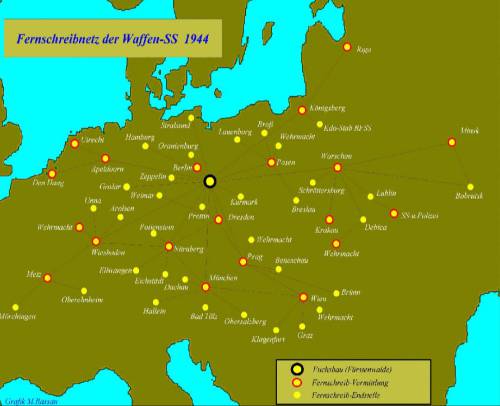Der „Fuchsbau“ von 1943 bis 1945

Wie der Bunker 1943 geplant wurde, soll meine Grafik veranschaulichen.
Der Bauwerkskörper mit seinen parabelförmigen Röhren wurde aus Kosten- und Zeitgründen einfach am Osthang einer bereits vorhandenen Kiesgrube platziert und in offener Bauweise errichtet. Die Hauptröhren aus Beton hatten am Fuß eine Wanddicke von 180 cm und oben 75 cm. Der Tarnname war „Fuchsbau“. Dieser sollte drei Monate zuvor noch an einem anderen Ort gebaut werden. Dafür hatte die SS-Führung jedoch keine Baugenehmigung erhalten. Ab Oktober 1943 konnte dann im Jagen 116 der Rauener Berge mit dem Bau des Bunkers „Fuchsbau“ und einer Funkbaracke für die Waffen-SS begonnen werden.
Durch Berichte eines 100-jährigen Ingenieurs aus dem damaligen beratenden Konstruktionsbüro des „Fuchsbaus“ von 1943, SS-Offizieren und Soldaten, die bis 1945 im „Fuchsbau“ dienten, sowie der Sichtung von verschollen geglaubten Baudokumenten und Aufzeichnungen von am Bau beteiligten Firmenangehörigen besteht nun Klarheit über Zweckbestimmung, geplantes Aussehen, den Bauablauf und die Funktion des ursprünglichen Bauwerkes.
Die Pläne für den Bunker "Fuchsbau" entstanden bei der Inspektion Nachrichten des SS-Führungshauptamtes auf dem Terrain des SS-Nachrichtenzeugamtes unweit des KZ-Sachsenhausen bei Oranienburg.
Geleitet von SS-Unterscharführer Radicke wurden im dortigen Konstruktionsbüro durch auserwählte KZ-Häftlinge die Planungsdokumente für den Bunker erarbeitet. Einem dieser Häftlinge, dem polnischen Offizier Marcinek, gelang im Sommer 1944 eine unglaubliche Flucht aus dem Konzentrationslager Sachsenhausen. Er erreichte die Westfront und stellte sich den alliierten Truppen. Ausführlich berichtete er über die Bauvorhaben der Waffen-SS im Berliner Umland. Dadurch erfuhren die Britischen Streitkräfte von der Existenz der stark befestigten unterirdischen SS-Nachrichtenzentrale. Aber auch über die in Ketschendorf bei den Bauarbeiten getöteten KZ-Häftlinge und dem berüchtigtem Lager an der Autobahn gab er Informationen.
Trotz mehrerer Planungsänderungen und ständigem Materialmangel konnte nach nur einjähriger Bauzeit im November 1944 der Dienstbetrieb im Bunker aufgenommen werden. Man begann noch mit der Überschüttung des Röhrensystems. Durch das Kriegsende blieb der Komplex aber außen unvollendet. So entstand in nur einem Jahr die wichtigste unterirdische Fernmeldezentrale für Himmlers SS-Truppen.
Der Rohbau sollte abschließend mit einer 25 Meter starken Überschüttung aus 500.000 m³ Sand und zwei mächtigen Bombenschutzplatten gegen Luftangriffe geschützt werden. Dazu wurde extra ein ganzer Hügel abgetragen.
Als im März 1945 die Bauarbeiten wegen der Frontnähe eingestellt werden mussten, war der Bau außen unvollendet. Die beiden Zerschellplatten zum Schutz vor Bomben und eine Verlängerung des Personalstollens um weitere 50 Meter konnten nicht mehr realisiert werden. Die Röhren waren nur an einigen Stellen mit sieben Meter Sand bedeckt. Der Bunker selber war aber bis Kriegsende rund um die Uhr in Betrieb gewesen. Der größte Teil der Räume wurde durch die Technik für Telefonie, Fernschreibbetrieb, Chiffrierung und Richtfunk in Anspruch genommen. Auch Trafostation, Notstromgerät und Klimatechnik waren vorhanden. Separate Dienstzimmer gab es im Bunker nur für den Leiter der Nachrichtenstelle und seinen Stabschef.
Mehr als 20 Jahre nach dem Krieg wurde von seitens überlebender Häftlinge in der Bundesrepublik Anklage gegen die verantwortlichen drei SS-Kommandeure erhoben.
Der erste Chef, SS-Standartenführer Loh, wurde nicht vorgeladen, denn es gab keine Kläger mehr, die ihn noch kannten. Er war nach dem Krieg in der Telekommunikationsbranche tätig und lebte bis zu seinem Tod unbehelligt in Heidelberg.
Der zweite Leiter, SS-Sturmbannführer Koller, war clever. Die Hamburger Staatsanwaltschaft hatte ihn vorgeladen und suchte aber einen SS-Offizier, der für das KZ in Ketschendorf verantwortlich war. Koller gab jedoch zu Protokoll, dass sein Dienstort sich in Petersdorf bei Saarow befand und wurde nicht belangt. Bis zu seinem Ableben 1989 betrieb er ein Hotelunternehmen in Passau.
Den dritten und letzten SS-Kommandeur, SS-Sturmbannführer König, konnte die Staatsanwaltschaft nicht identifizieren. Was USA-Historiker wussten, jedoch den westdeutschen Behörden nicht bekannt war: König hatte sich beim Rückzug des Fürstenwalder SS-Nachrichtenregimentes im Mai 1945 in Bayern durch Selbstmord aus der Verantwortung gezogen.

Ende 1944 hatte die Waffen-SS ihr eigenes Fernschreibnetz entfaltet, dass sich wie ein Spinnennetz zwischen Riga, Warschau, Prag, Wien, München, Metz, Apeldoorn und Berlin ausbreitete.
Die neu verlegten Führungskabel dieses Netzes liefen im „Fuchsbau“ zusammen, der noch im Oktober 1944 der Führungsnachrichtenabteilung 501 der Waffen-SS unterstellt wurde.
Zu Kriegsende unter dem Kommando von SS-Sturmbannführer Wilhelm König, konnten auch hochrangige Offiziere der Wehrmacht den Bunker besichtigen.
Als sich die Panzer der Roten Armee Fürstenwalde im April 1945 näherten, verließen die letzten SS-Einheiten den „Fuchsbau“ in Richtung Zossen und machten die zurückgelassene Technik unbrauchbar.
Die Geräte und Baumaterialien wurden später demontiert und einzelne Stollenabschnitte durch die sowjetischen Truppen gesprengt.
Die Reste wurden weitgehend von der Bevölkerung im zerstörten Ketschendorf und anderen Orten verwertet.
Die verantwortlichen Bauleiter des Fuchsbau-Bunkers waren SS-Männer und überlebten den Krieg.
Einer führte in Westdeutschland seine Baufirma weiter.
Der Andere gab sich als KZ-Häftling aus und wurde Leiter eines Institutes an der Bauakademie der DDR.
Nach Übersiedlung in den Westteil Deutschlands war er an zahlreichen Großbaustellen in leitender Stellung tätig und starb erst 2001.
